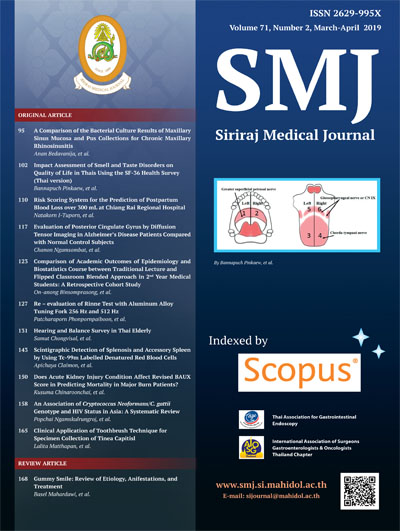Scintigraphic Detection of Splenosis and Accessory Spleen by Using Tc-99m Labelled Denatured Red Blood Cells
DOI:
https://doi.org/10.33192/Smj.2019.22Keywords:
Accessory spleen; denatured red blood cell; immune thrombocytopenia; splenosis; spleen scintigraphyAbstract
Objective: To evaluate the usefulness of Tc-99m-labelled denatured red blood cell scintigraphy (DRBCS) in the detection of splenosis and accessory spleen.
Methods: This retrospective study reviewed 7 patients who were suspected of splenosis and accessory spleen during 2007-2014. Six patients had undergone total splenectomy before the DRBCS study. Multi-planar, SPECT and SPECT/CT images of DRBCS were reviewed by visual analysis. Image findings were correlated with other imaging modalities and clinical presentations at follow-up.
Results: DRBCSs were positive in 6 patients; 5 splenosis and 1 accessory spleen. A single lesion was detected in each patient. Locations were in splenic bed (5 patients) and in pelvic cavity (1 patient). Mean lesion size was 3.7 + 2.4 cm. SPECT or SPECT/CT imaging could eliminate false-negative results in 2 patients. Lesion uptake intensity
in 4 patients was higher than in the liver. Two patients had subsequently undergone resection of the lesions and pathological examinations confirmed the diagnosis of splenosis and accessory spleen. Sensitivity of DRBCS was comparable with other imaging modalities. However, DRBCS was more specific for the splenic tissue.
Conclusion: DRBCS is useful for the detection of splenosis and the accessory spleen. Detection sensitivity of DRBCS is better than ultrasonography(US). DRBCS is more specific to the splenic tissue, compared with US and CT. Furthermore, SPECT/CT imaging increases sensitivity, lesion localization and characterization. Clinical impact
of DRBCS is apparent including pre-surgical localization, elimination of additional follow-up imaging and invasive procedure.
Downloads
Published
How to Cite
Issue
Section
License
Authors who publish with this journal agree to the following conditions:
Copyright Transfer
In submitting a manuscript, the authors acknowledge that the work will become the copyrighted property of Siriraj Medical Journal upon publication.
License
Articles are licensed under a Creative Commons Attribution-NonCommercial-NoDerivatives 4.0 International License (CC BY-NC-ND 4.0). This license allows for the sharing of the work for non-commercial purposes with proper attribution to the authors and the journal. However, it does not permit modifications or the creation of derivative works.
Sharing and Access
Authors are encouraged to share their article on their personal or institutional websites and through other non-commercial platforms. Doing so can increase readership and citations.















